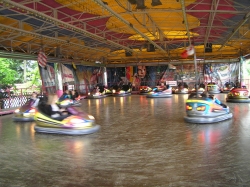Heat is a dance party. Sound silly? Well, there are plenty of silly things in science, so prepare yourself. When something heats up, say a potato, its building blocks start to shake. They begin to dance. If the potato's dancing blocks get close to something else, say some butter, they will make the butter's building blocks shake and then melt. Sometimes when others are dancing, you just have to dance too. Of course, just like a dance party, there are going to be great dancers and not so great dancers.
Building blocks don't actually dance, though, do they? If you look up close, you will see that the smallest parts of our hot potato are going crazy, moving all around. When they touch the butter, they start bumping into the butter's small parts, making them move all around. A
collision is when two things crash into each other. You can crash cars, crash into someone on the playground, or a ball can crash through a window. This happens on a small scale all the time. It may sound dangerous, but things have to get really hot to start a fire. Most things just get excited. Really, it's not quite like dancing. It's more like a lot of tiny crashes. But dance party sounds nicer, doesn't it?

Now this is my kind of collision!
Karsten11, Public domain, via Wikimedia Commons
Have you ever seen invisible lines wiggling off a really hot road? How about off a stove? Heat is making the air dance! Let's find something you can touch, so you can really get the experience. Ah. Touch this mug of hot chocolate. Feel that warmth? The heat in the cup is making the building blocks in your hand dance. This is called
conduction, when things touch and heat moves from one thing to the other. If only you could make other people dance on the dance floor just by touching their shoulders.

Who doesn't love hot cocoa?
4028mdk09, CC BY-SA 3.0 , via Wikimedia Commons
Just like on the dance floor, some things are better dancers than others. I am not saying they are bad dancers. They just don't get into the swing of things.
Insulators are things that heat cannot move through easily. One common example is wool. If you put a hot mug of cocoa on one side of a blanket and touch a spot about a foot away from it, that spot will still be cool. If you pour the hot chocolate into a cup made of styrofoam, you can hold it without getting burned. Styrofoam and wool are bad dancers. Wait. That's mean. Instead of saying they are bad dancers, we will say they are good at keeping the heat party in one place.

The styrofoam keeps the cocoa hot. What holds the bear together?
Now let's talk about the party animals. Some stuff dances so well they will carry heat from one end to the other in seconds.
Conductors are anything that carries heat easily. This can be anything from some kinds of metal to water. If you heat up water, the dancing will spread through it very quickly and all the different parts of a pot of water will be close to the same temperature. If you heat it enough, it can start to boil. The water building blocks will dance so much that they will dance away from the party as steam. If you put a fork on the stove and try to pick it up, your fingers will get burnt. The metal is a little too good at dancing. Calm down metal, no need to show off.

Metal conductors are good for heating, bad for touching.
GRAN, CC BY 3.0 , via Wikimedia Commons
In the world of heat, there are good dancers and then there are those who keep the dancers all in one place. We use them for different things. Sometimes we need to keep heat out with insulators. Think of your house on a hot summer day. And sometimes we need to keep heat in, like styrofoam holding in the hot chocolate's heat. At other times, we need to spread out the heat as much as we can with conductors. That's like a pan on a stove or a portable heater. Controlling these things is kind of like having the volume knob at a party. When you have control of heat, you have control of the dancing.
References:Science Kids. "Heat Transfer" Science Kids, 2010. <
http://www.sciencekids.co.nz/gamesactivities/keepingwarm.html>
Perritano, John. "Top 5
Green Insulation Options" HowStuffWorks.com, 2011
<http://home.howstuffworks.com/home-improvement/construction/green/5-green-insulation-options.htm>
Science Buddies Staff. "Which
Materials are the Best Conductors?" Science Buddies.
Science Buddies, 2014.
<http://www.sciencebuddies.org/science-fair-projects/project_ideas/Elec_p018.shtml>